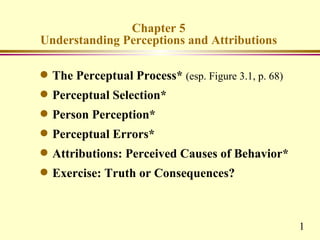
Organizational Behavior Chapter 5
- 1. Chapter 5 Understanding Perceptions and Attributions q The Perceptual Process* (esp. Figure 3.1, p. 68) q Perceptual Selection* q Person Perception* q Perceptual Errors* q Attributions: Perceived Causes of Behavior* q Exercise: Truth or Consequences? 1
- 2. Perception q Definition: The process by which people select, organize, interpret, and respond to information from the world around them. s Perception (consciously and unconsciously) involves searching for, obtaining, and processing information in the mind in an attempt to make sense of the world q Selection and organization often account for differences in interpretation/perception between individuals observing the same stimuli 2
- 3. Basic Elements in the Perceptual Process* (See Figure 3.1, page 68) Observation Environmental * Taste * Smell Stimuli * Hearing * Sight * Touch Perceptual Selection Perceptual * External factors Organization * Internal factors * Perceptual grouping Interpretation Response * Perceptual errors * Covert * Attributions * Overt 3
- 4. Concepts Manifest in the Princeton Case q Selective Screening: the process by which people filter out most information so they can deal with the most important matters q Perceptual Set: an expectation of a perception based on past experience with the same or similar objects q Pollyanna Principle: the notion that pleasant stimuli are processed more efficiently and accurately than unpleasant stimuli; an effect of motivation on perception q Perceptual Grouping: tendency to form individual stimuli into a meaningful pattern by continuity, closure, proximity, or similarity 4
- 5. Person Perception q Definition: the process by which individuals attribute characteristics or traits to other people; closely related to attribution q Implicit personality theories: personal beliefs about the relationships among other’s physical characteristics, personality traits, and specific behaviors q Impression Management: the attempt people make to manipulate or control the impressions others form about them 5
- 6. Common Perceptual Errors q Perceptual defense: the tendency for people to protect themselves against ideas, objects, or situations that are threatening q Stereotyping: the tendency to assign attributes to someone solely on the basis of the category of people, of which that person is a member q Halo effect: the process by which the perceiver evaluates another person solely on the basis of one attribute, either favorable or unfavorable q Projection: the tendency for people to see their own traits in others q Expectancy effects: extent to which expectations bias how events, objects, and people are actually perceived s Self-fulfilling prophecy: expecting certain things to happen will shape the behavior of the perceiver in such a way that the expected is more likely to happen 6
- 7. Nature of the Attribution Process* q Definition: The ways in which people come to understand the causes of their own and others’ behaviors q Most often an unconscious process (i.e., people are not normally aware of making attributions) q People are constantly attributing the behavior of themselves and others to either internal (i.e., personal) or external (i.e., situational) causes. 7
- 8. The Attribution Process Antecedents-- •Information factors internal •Beliefs to the perceiver •Motivation •Perceived external Attributions made by the perceiver or internal causes of behavior •Behavior Consequences for the perceiver •Feelings •Expectations 8
- 9. Theory of Causal Attributions Consistency s Does person usually Ye Ye s behave this way in this situation? Distinctiveness External Attribution Does person behave Internal Attribution No (to person’s situation) Yes differently in different (to person’s disposition) situations? Consensus Ye s Do others behave No similarly in this situation? 9
- 10. Frequent Attribution Errors* q Fundamental Attribution Error = overestimating the personal causes for other’s behavior while underestimating the situational causes q Self-Serving Bias = attributing personal success to internal factors and personal failure to external factors 10
Notes de l'éditeur
- 18
